Yogi the peregrinator
The adventure of a Yogi
The File is Under Construction
Veeraswamy Krishnaraj
Damodaran had a dual practice in Periavadi in Tamil Nadu. He first entered Veterinary College and became a veterinary doctor; soon thereafter he entered medical College and after graduation trained as a General Practitioner. One office was for veterinary practice and the second one was for adults and children.
Damodaran always treated people and animals as equals. We are at the top of the evolutionary ladder. People share the same organs, enzymes, genes… with animals of higher and lower order.
James Gorman in his NYTimes article puts it humorously this tidbit.
"I’m delighted to be related to flies, yeast, frogs, chimps, and blue-green algae. I find the serenity of algae restful and the ambition of yeast admirable. Frogs are great jumpers. Chimps have hands at the end of their feet, sort of. And fruit flies, well, I never met a fruit fly that I was ashamed to share genes with, and I certainly can’t say that about human beings."
As we look at the Grand Tree of Life, we see Origin, Grand Confluence, Trunk, Primary branching points, secondary branches, rendezvous points at many branching Vs terminal branches and the rest, we trace life back to a repository of DNA of all life, the Stem Substance, Avyaktam (the Unmanifest) and Akṣaram (the Indestructible).
The message of all religions is we are all created by God. If bacteria have the potential to become a human, the latter should have the potential to become god. This means that a human can become more sattvic (virtue, goodness) than he is now. Man is an incarnate of God in a limited and restricted sense. God is Maxi. We are all a bunch of Mini-s. God is Omniscient, Omnipotent and Plenipotent; we are parviscient, parvipotent… All beings from plants to bacteria to animals to man have sentience, which the plants and the bacteria have in the least amount. The animals have in a small amount and man has in the most amount. That common sentience is the basis for nonviolence to any, or at the most as slight (violence) as possible.
Man has all the genes that a mouse has; our 300 special genes are unique to humans: Genetically speaking we are mouse first and human later. Even worse is that we share genes with round worm. Chimps and humans share 99% of the genes; Twenty-five percent of human genes are shared with banana. We share many genes with the cow. God has one design and many plans and variations.
The truth is our origins are lowly, and we try to rise and blossom like a lotus flower whose origin and roots are in the slimy mud. "Human genes make more proteins per gene (three on average) than many other organisms. Human proteins are more complex than those of many other organisms."
The chimp in its cosmic compulsion to excel loses its tail, walks on two feet, struts along, and becomes a champion of a human. On the same cosmic compulsive trait, man becomes god. Our lower traits recede and the higher traits evolve or take hold. We lost our tail and our jungle habitats, we are now humans, and we are on our way up the ladder. We have many of the animal qualities, some benign and welcome, some malignant and unwelcome. In pursuing higher transcendental consciousness, the Yogis, the Rishis and the Munis are the trailblazers: Krishna, Buddha, and Jesus.
Now back to Damodaran. He studied Botany, zoology, and geology in his premedical courses. His formal education that included matter, fauna, flora, and humans gave him a good perspective about nature and beings. Since he was from the family of religious people, he had a good grounding in Hindu philosophy. He was a Vaishnavite with a belief in Viśiṣṭādvaita: Isvara, Cit and Acit (Personal God, the Sentient and the Insentient).
As he earned a living from his dual practice, he gained supernormal siddhis of a Yogi. In his practice he learnt the hidden language of the animals and people. He came to know their unexpressed likes, dislikes, complaints, and satisfaction by his knowledge of their physiognomies. Many were like those of people. They expressed their gratitude to him in their special ways. Their gratitude was sincerer than those of people.
One day he had an epiphany, sold his practice for next to nothing to his colleagues and went on a journey, his inner light being his guide.
He was single and therefore did not have to leave a grieving family. He walked on foot, forded the shoals, ascended the hills…wherever ambulation was possible. In his peregrinations, he ate fruits, vegetables…available in the forests and public lands and food at Choultries (In the west, Soup Kitchens). His demeanor was so dignified and impressive, people invited him to share their meals in public places.
The Decoits Tried to Do Him In.
He trudged up a hill in a forested area. There was a clearing on the top of the hill. He slept under the open skies. It was pitch black as the night fell. That was the hiding place for the decoits. They had no qualms about robbing and killing. That was their calling. They had shrines scattered around in the forests. They prayed before and after their nefarious acts. One of them noticed the Sadhu coming to the plateau and resting. His possessions were a bamboo stick and a Kamaṇḍalam (கமண்டலம் = Water-vessel). He slept on the bare floor in the dark of night. Four of the decoits, with intent to kill, approached him to do their dastardly act. He was fast asleep. They had their weapons at the ready: swords, spears…The spearman raised his spear and plunged it on the sleeping Sadhu. There was no cry, sound, spill, or movement. They wondered what happened to the man. The head decoit struck a match and saw no man on the ground and only the spear. As they were looking for the man, a bear jumped on them and mauled them bad. All four had deep gashes on the feet and thighs. All scooted out in a hurry with a trail blood. They have been put out of business until the wounds healed. Next day, other decoits were looking for the bear in the forest. They never noticed a bear in their locality. Their search was futile. Did this bear attack teach them a lesson? Only time will tell.
Damodaran, groggy from an interrupted sleep, went down the hill during the night and sought refuge in a choultry a long distance from the edge of the forest. There were a ton of people. He slept on a flat rocky floor of the choultry for a few hours.
How was it Sadhu was not speared by the decoit, though they saw him sleeping on the bare ground? It was a mystery wrapped in a puzzle, further wrapped in a riddle. How did the bear appear suddenly mauling the miscreants? What became of the decoits?
Next day, thanks to the Choultry, he had a breakfast of Kuzh (கூழ் = porridge) and left the premises.
The next destination, he did not know, neither did any. There was an Indian Eagle flying and surveying the land below from its flight path. The eagle landed. Damodaran, the Sadhu was on his way.
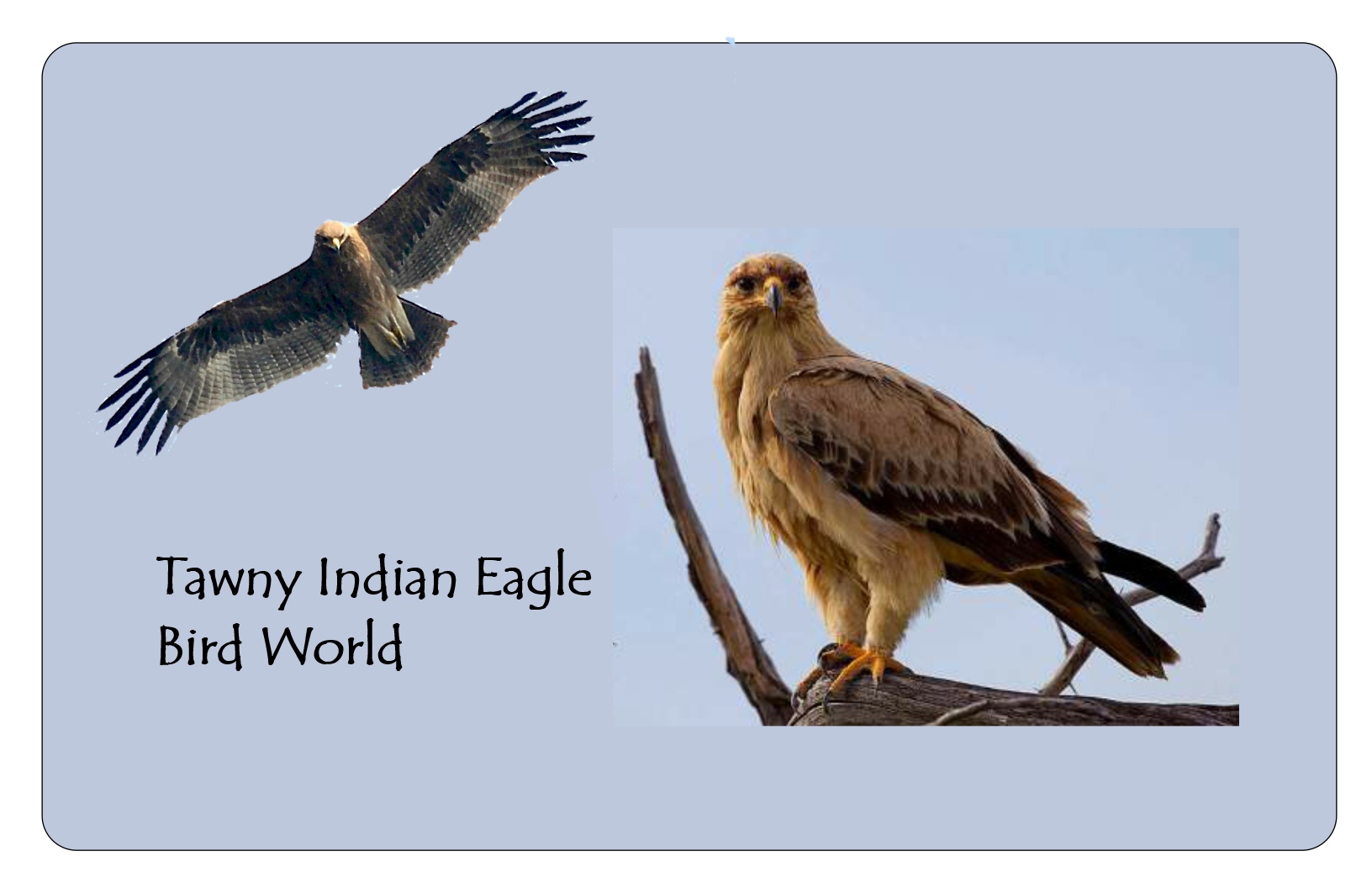
The Yogi and the King
The Sadhu walked towards the temple, looking for the temple Gopuram (tower). Again, he had to walk through a jungle. Still the gopuram was nowhere to be seen. He came across a group of people in the official uniform of servants of a potentate, who were also destined to go to the temple. The servants took him to the petty king, who was glad to see the Sadhu. Sadhu had lunch with the king, discussed with him about philosophy, statecraft… and asked the king to take leave of him. The king said he would arrange for a Pallakku (பல்லக்கு = Palanquin) to take him to the temple.
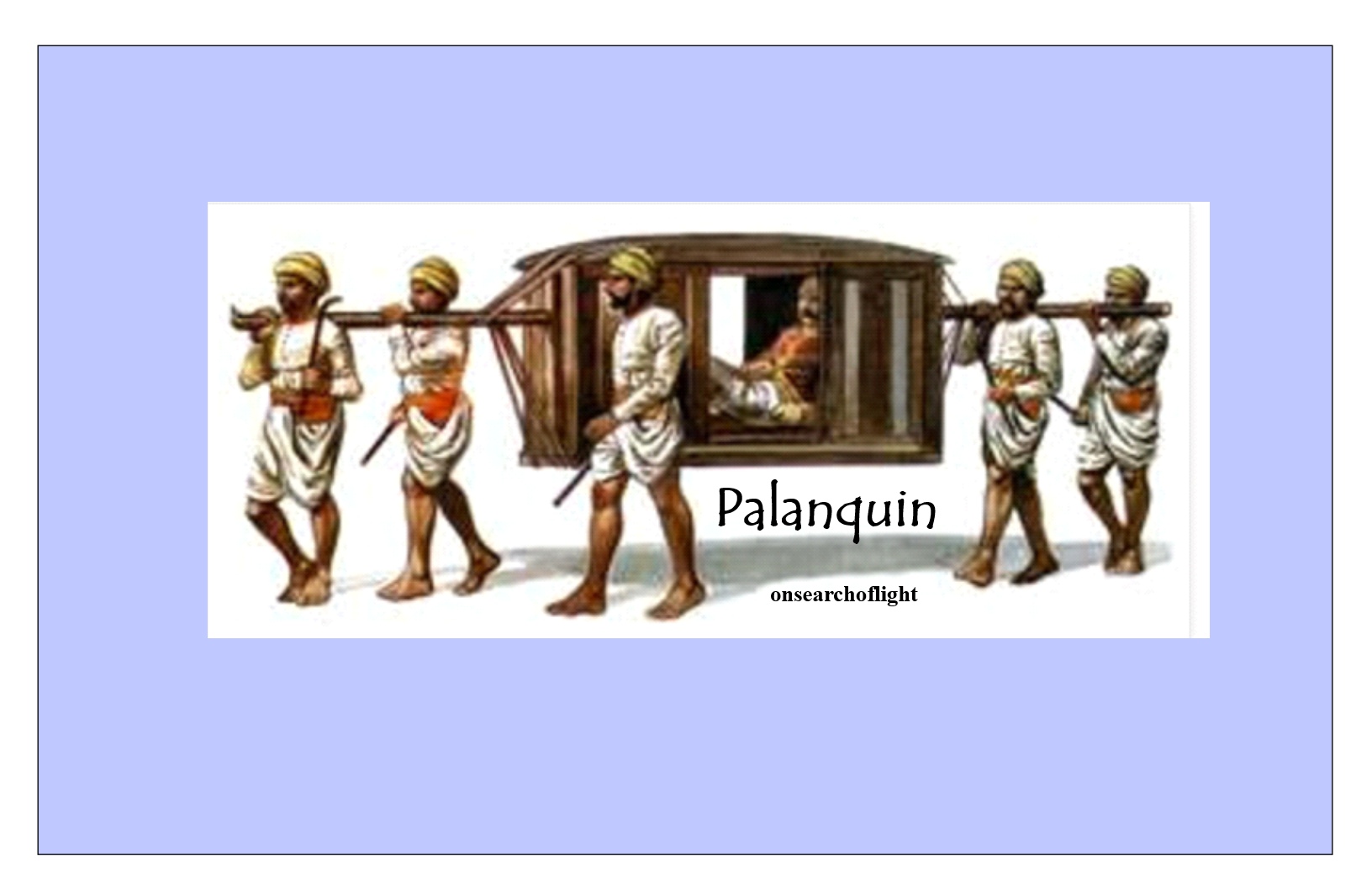
The Sadhu thanked him for the offer and politely declined saying, “I always walked. God willing, I will see you at the temple.” The king presented a signet ring bearing the Royal Seal as a passport to get past his servants to reach the king. The servants introduced the Sadhu with the ring to other servants and the king’s office bearers, so they knew it was a gift and a passport to approach the king.
Yogi's Transmutation to a Monkey.
He took leave of the king and was on his way to the temple. He became very thirsty and found not one drop of water to drink. His water-vessel was empty. In his forest path, he found no streams. He noticed a bunch of coconut palm trees with coconuts at the top. He was not used to climbing tall trees.
A monkey climbed up the tree and brought down three coconuts. He thanked the monkey for the fruits. He laid the Kamandalam and the staff on the ground. The stick morphed into a scimitar, which he used as a knife to pare the green skin and the tough husk and put a hole in the shell. The monkey was long gone. He alone drank the coconut water. He saved the kernel and the extra coconut water in the Kamandalam. As the evening sun was dipping into the horizon, he sighted the temple tower and reached the temple by nightfall. The temple was serving the evening meals to the devotees. He joined them for the meal.
A Robber Steals the Ring. The Bamboo Stick's Spontaneous Act of Thrashing the Robber.
He went inside the temple for Darśan of Lord Venkatesvara. With all his physical needs satisfied that day, he slept on the rocky floor of the choultry. There were robbers mixing with the devotees. One such robber saw the glistening ring tied to the bamboo staff. He had the desire and the urge to steal the ring. The Sadhu was asleep. He thought Sadhu won’t miss his ring, if he took it. He tried to untie the ring from the staff. Accidentally it fell into the bamboo stem cavity. He turned the bamboo stick upside down, but the ring did not drop down. He took a big rock and banged on the stick. Accidentally he hit his middle finger with the rock. He yelled out. No one woke up. He was glad. He carried it outside but the lower end got caught in the crevice between the rocks. When he tried to pry it out, he fell backwards hitting the head. He remained unconscious for several hours. When he woke up, the stick was gone with its owner the Sadhu.
The Sadhu went for the morning Puja services in the morning. The young bandit was there too. He was a professional pickpocket, mixing with the devotees and stealing their valuables. Easy victims! Easy money! They crossed their paths. The Sadhu asked him, “How is your bruise in the back of the head. It must be hurting.” The bandit could not believe what he heard and saw the bamboo staff with the ring in the cavity.
As he was walking out of the temple premises close to the central shrine, he felt taps on his shoulder, turned around and saw a person pointing to the king. The king prearranged for a special puja. The Sadhu approached the king, who asked him to join him for the special puja, which he gladly accepted. The Sadhu spent the rest of the day with the king, who asked him to stay with him for a few more days at the temple town, to which the Sadhu agreed.
The Sadhu, knowing that the ring attracted the attention of the thieves, he looped the Waist Cord (அருணாக்கயிறு Aruṇā-k-kayiṟu) through the signet ring, so it remained unseen from the prying eyes.
The king returned to his kingdom and the Sadhu went on his way exploring his kingdom of adventure. He took a jungle path wherein there were wild elephants, tigers, lions, deer, hogs, cobras, foxes, langurs, rhesus monkeys (a macaque, Macaca mulatta), bears…He saw a lion limping on its right foreleg. He approached it without fear and stopped in front. It raised the right paw. The Sadhu went down on his knees and shins and removed the thorn. Immediately the lion gave a roar and they became friends. The lion led Damodaran to its cave where it introduced him to the lioness and his cubs. The Sadhu made easy friends with the cubs, played with them, and let them climb over him. He stayed with the lion family for a few days, eating fruits, roots, and nuts.
Other animals like the deer and hogs watched the close friendship between man and lion. They took off in a hurry, when the lion turned around and gave a roar.
The Sadhu bid goodbye to the lion family and went on his adventurous path. He reached a riverbank and saw a herd of elephants drinking water. He wanted to go across the river and requested the matriarch to take him on its back across the brisk rapids. The elephant kneeled its left foreleg, Sadhu climbed, sat on its neck, and crossed the river on the elephant’s back. After dropping him off, the elephant joined its herd.
The Yogi Goes to Circus, Faces an Escaped Lion and Calms It Down.
He was at the edge of a modern town. The residents were friendly. He spent a few days in the house of a priest for rest and relaxation. There was a circus in town with clowns, daredevil motorcyclists, elephants, lions, tigers, camels, horses, stubborn mules… There were circus clowns, jugglers, tightrope walkers, unicyclists, circular-cage-riding motorcyclists, equestrian circle rides with blindfolds…
All seemed to go well. The people were enjoying the show. A lion escaped the netted corral and moved to the stands. The patrons in a panic moved away from the charging lion. The lion trainer ran after it shouting his orders. Nothing helped. The Sadhu jumped in front of the lion, ordered it to stop and led it back to the corral. The owner of the circus and the lion trainer profusely thanked the Sadhu and offered a high paying job as an Animal Welfare Specialist. The Sadhu declined but said that he would stay for a few days to calm down the stressed animals. He entered the cages of the wild animals, spoke to them in soft voice and calmed them.
His name and fame spread far and wide: Yogi Damodaran speaks to animals and calms them down. He left the carnival grounds and again was on his peregrination into the world of the unknown.
The Yogi Rides on the Back of the Croc.

He came to the banks of the river where a crocodile was sunning on the rock. The yogi asked the croc on the rock if he would take him across the river to the other bank. The croc on the rock sunning after a sumptuous meal told the Sadhu, “I just had a heavy meal. Give me 15 minutes. I will take you across the river. “Fifteen minutes went by. Sadhu was waiting patiently. The croc told the Sadhu, “Climb up on my back and hold on me firmly, the rapids are vicious in the middle of the river. On reaching the other side, you must do me a favor” Sadhu: “What favor would that be?” Croc: “You must initiate me into the mysteries of Saivism with a Mantra.” The Sadhu agreed and said, “Why do you need a Mantra, being a croc.” The croc: “I was a Tantric in my past life. I ate the meat of a forbidden animal. My Guru cursed me to take a birth as a river crocodile and my sin would be expunged when I utter the Mantra given by a Sadhu. You are that Sadhu.” The Sadhu was very happy to free the croc from its curse.
The Yogi climbed on the back of the croc. The ride was rough from the rock and roll movement of Sadhu’s bottom on the croc's bony plates. Besides, other crocs came near him tugging on his clothes. They meant no harm. That was a frightening experience. At last, the croc and the Sadhu reached the riverside. Sadhu uttered the Mantra. The croc said, “Hold on Sadhu, let me move the flap covering my tympanic membrane. Go on you may give my Mantra now.” The Sadhu gave the croc a short and easy to remember Mantra: OM. The croc uttered the Mantra and immediately mutated into a young man. Both were surprised at the turn of events.
The Sadhu gave a piece of his cloth as a loincloth to the crock-man. He thanked him profusely. Soon after, they parted ways.
The Mongooses and the Cobras.
Soon after Yogi Damodaran left the Croc-man, he went to sleep under the shade of a tree. A quiver of cobras was slithering towards the trunk of the tree seeking shade. Right behind them were a gang of mongooses, overtook the cobras and surrounded the tree and the Yogi. The cobras danced, spread their hoods, and hissed. The gang snarled back to the cobras and aggressively moved towards them in a coordinated manner. The cobras turned tail seeking shade under another tree. Damodaran was seeing all these happening in his vision as he slept. He woke up and thanked the gang for their noble gesture in protecting a helpless man. This quality and nobility extend to the elderly mongooses. The younger ones take care the needs of the elderly. As the cobras left in a hurried manner, the mongooses disappeared in a moment as if my magic. They were not seen leaving from under the tree.
Image of Mongoose and Cobra from YouTube
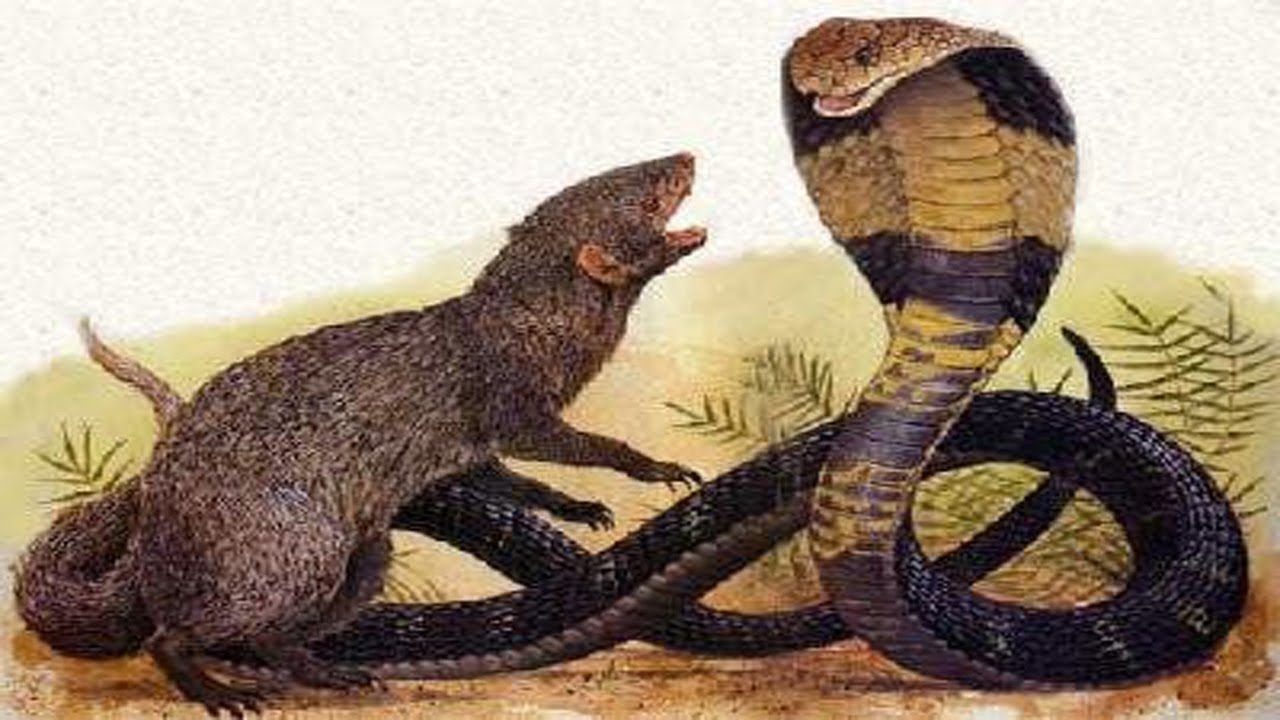

Two Troops of Monkeys Vie for Dominance. Yogi Brings Pace.
The Sadhu passed through a jungle with wild animals. The monkeys had a free reign there and therefore the two dominant troops were always at loggerheads fighting over domains of food and mates. As he was taking rest under a huge mango tree, a troop of monkeys descended on him. They were on the trees, on the ground and everywhere. They were chased by another troop from a luscious part of the forest redundant with fruit trees. They did not understand ‘live and let live’ or sharing the food. The alpha monkey held the largest harem. Any stealthy consortium by the Beta monkey led to fights, bruises, gashes, bleeding… There was one senior and sedate monkey with one eye clouded by traumatic cataract and other eye with faint vision. He always scrounged for leftovers. His good times were long past gone.
The two Alpha monkeys came to the Sadhu complaining of domains of food and mating rights. The yogi pointed out to the near-blind monkey who lost vision from injury to the eyes and sustained many painful scars on the face and limbs from fighting. He told them, “This is no life. There is plenty of food and companionship to be had for both troops. Learn to live in peace. Let the wayward male or female go its way. Don’t fight the errant simians. You both will live longer under my advisory.”
The Sadhu stayed with them for a few days. They changed their behavior and learnt to live with each other. The two troops joined hands and became one large troop.
The Sadhu was well taken care of by the monkeys during his stay. They brought him bananas, forest fruits, Palm fruits… having enjoyed their hospitality and brought amity between fighting troops, he made his way out of the forest.
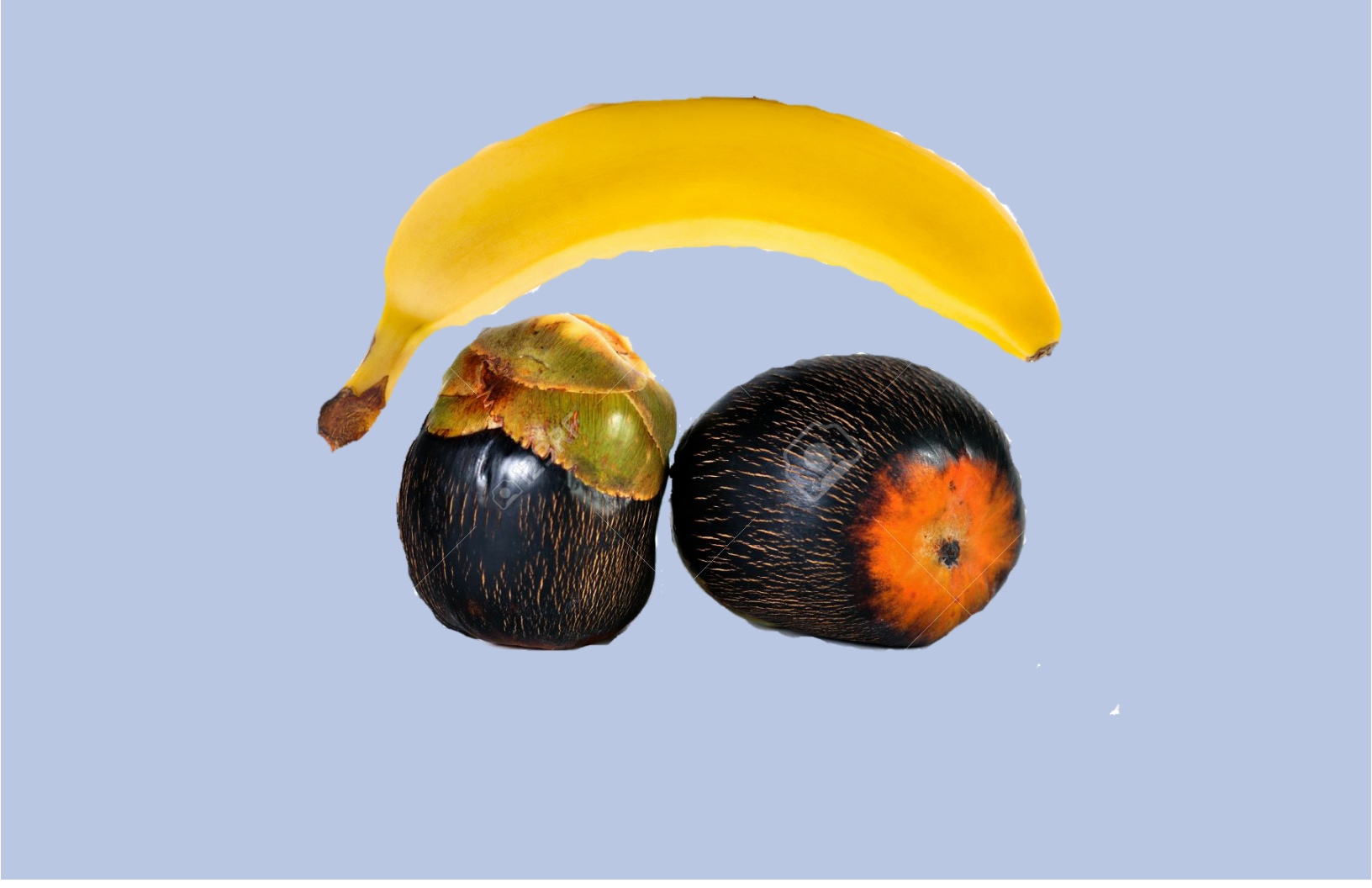
The now friendly two alpha monkeys of the merged troops accompanied the Sadhu to the edge of the forest and bid him goodbye. He saw a temple tower at a walkable distance. He trudged up the path with some difficulty and reached the temple by noon with the sun at the hottest. He made a beeline to the choultry for a well-deserved meal. He ate and took his siesta in the Mandapam. The quarrelsome and the thieving monkeys in the temple were screeching, screaming, taunting, and fighting with each other. Some stole bananas from hapless children and adults. The reverence of the devotees for the monkeys emboldened them to steal food from the passive visitors. After his siesta, he toured the famous temple town.
The Charging Elephant in Musth.
Elephant is a fixture in temples. Their participation in the temple festivals makes the festival more attractive and grander. One rutting elephant in musth took off from the temple trampling the livestock and people. The yogi saw it coming in his direction with people running behind it. He pointed his bamboo stick in its direction. The elephant stopped running and raised its trunk to the yogi in homage. The mahout took charge of the elephant and took it back to the temple. The temple town came to know of the miracle performed by the yogi and welcomed him with open arms. Luckily, the elephant injured no one.
He received a welcome from the temple authorities and the priests. They asked him how he stopped an elephant and made it calm. He just smiled at them and did not tell how he did it. He went near the temple elephant away from the crowds in a protected area and whispered a Mantra in his ear. Only he and the elephant knew the Mantra. He came out of the enclosure and told the authorities, the priests, and the mahout that the elephant would give no trouble to any one anymore and asked them not to chain it anymore but keep it in an enclosure with high walls.
The yogi left the company of the grateful people of the temple town and went where his foot took him. He could not see far because of a sandstorm. There came an Indian Eagle, who took off into the sky for aerial survey of the land ahead. The eagle came back and the Yogi walked in another direction to avoid the raging sandstorm. Thanks to the Indian Eagle.
The Decoits Fall into The Snake Pit.
The yogi's luck ran out soon. It was night. He faced the most fearsome and dangerous bandits on his way. They caught him by his beard and tuft. He lost the bamboo stick and the water-vessel in the melee. There was nothing of value on him. They wanted to kill him because it was a sport for them. The Yogi told them he knew of a place where there was gold, if they let him go. The headman said, he would let him go, after they lay their hands on the gold. He assented to their proposal. He took them to a lonely place where there was a dry well. They went down the side of the well leaving one man to keep a watch on the yogi. They found shiny objects at the bottom of the well. They shouted to let the yogi go. The Yogi was let go. A big stick landed on the back of the watchman-thief. He went tumbling down to the bottom of the well. The shiny objects turned into snakes. They yelled and scrambled to get out of the pit, writhing with snakes, which bit everyone. They thought they would die. The head robber said, the bearded man cast a spell on them. They would catch and kill him, once they were out of the pit. As they climbed up the sides, the mud wall loosened and fell on them. They stayed in the snake pit until daybreak. None died but they all had bite marks. They were not poisonous snakes. They were in the snake pit for six hours. The Yogi was long gone. The headman said, his Kula daivam of family goddess cast a curse on them because they did not offer homage to her before their nefarious activity.
The Yogi reached a village by morning and told the headman that people fell into a snake pit the night before. The headman took five volunteers to rescue them. When they reached the pit, the robbers were still in the pit. The volunteers recognized them as thieves, who promised they would not steal or kill anyone, if they were rescued from the snake pit. The volunteers tied a rope to a huge rock and dropped it in the pit. One by one they climbed up the knotted rope and emerged with bruises and snakebite marks. On dead snake was hanging on a robber’s leg by its fangs. The volunteers took the robbers to the village and marched them on the main street. The people threw sticks and cow dung on them. Once they were subjected to public shaming, they were let go with a warning not come back to their village.
The Yogi was in a decoit territory with safehouses. He was not yet safe. The released decoits told his compatriots about the bearded man with a bamboo stick and a water-vessel getting them into trouble. They wanted to wreak vengeance on the yogi. Within hours of release, the decoits reinforced with their comrades scoured the surrounding forest and the neighborhood for the Yogi. The Indian eagle flew overhead looking for the ruffians. The eagle saw a group of men wielding knives, swords… scouring near the edge of the forest. They were too close for comfort. The eagle instead of landing kept on flying far away from the killers. It must have gone about 12 miles. The eagle landed and the yogi resumed his journey on foot.
The news spread far and wide that the decoits were looking for a Yogi, who got the decoits in trouble. The yogi wanted to stay anonymous for two weeks, so he could travel the country safely. He underwent many transfigurations: a monkey, a feral dog, a fox, a cow, a cat…
Google images: Medley of animals
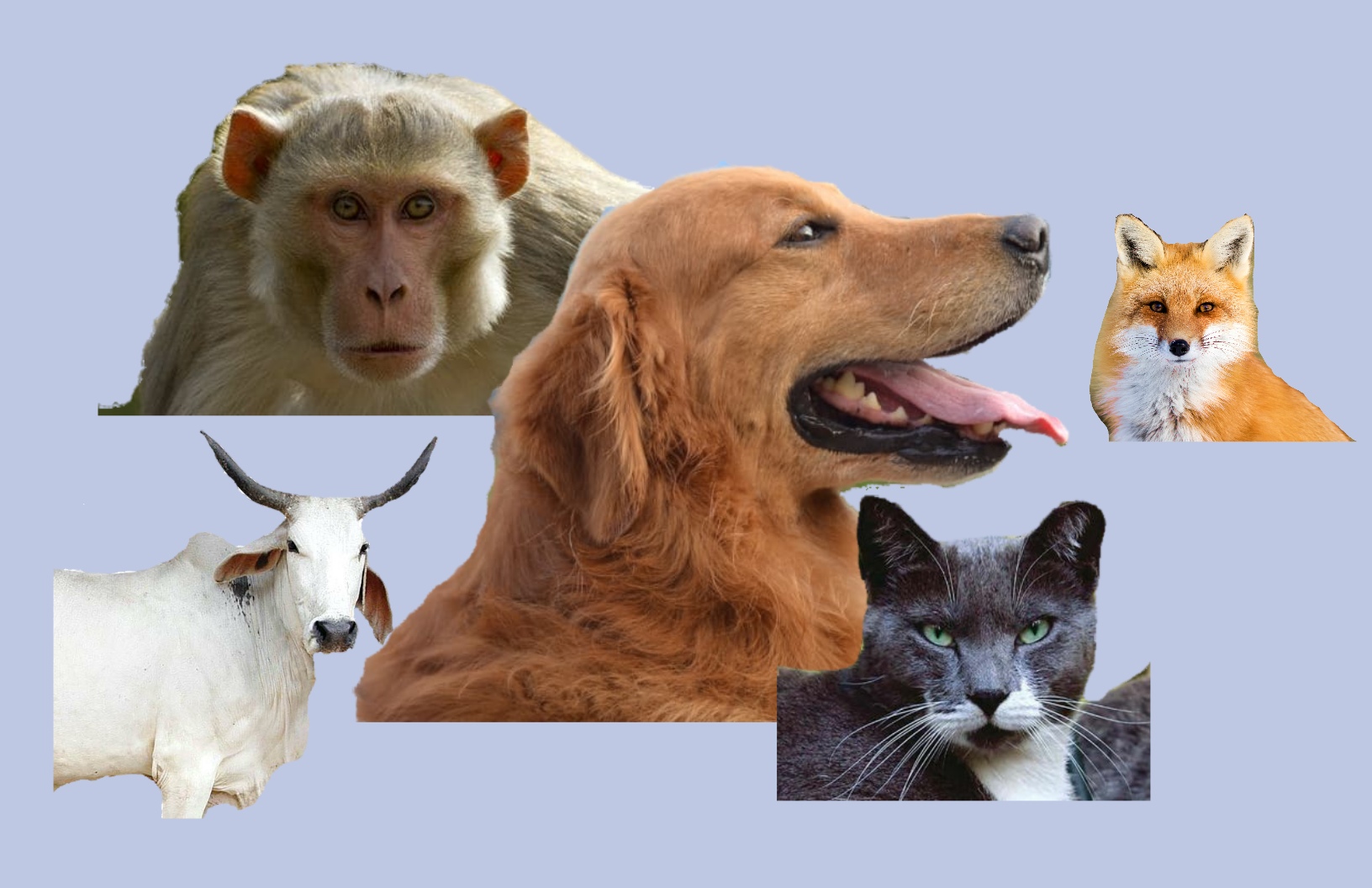
The Pilgrims' Camp
The yogi reached an open space occupied by pilgrims. They were taking rest for a few days before resuming their pilgrimage. There were a few trees. Some rich people had their tents erected for privacy and relief from the sun, the rain… Robbers moved among the pilgrims. The yogi made sure not to allow the robbers to take advantage of helpless people. He transmuted into a licensed dog with license tag hanging from the neck and moved in a grid fashion surveying the area for any trouble. He disguised himself as a rich pilgrim. He walked the dog sometimes. There were about four robbers. They looked for the most vulnerable, the young, the old and the female. Sometimes he moved as an invisible person. He saw a man trying to remove the gold chain off the neck of a one-year-old girl. The invisible yogi landed one severe blow on the back with his invisible bamboo stick. He made a loud cry, turned around to look for the beater and not finding one, he ran away for good from the pilgrimage area.
The yogi made rounds as the invisible person with his dog. One robber entered the tent, held the occupants at knife point and demanded cash and jewels. He saw it with his magical eyes. He sent his dog into the tent and the dog jumped on him and bit the hand holding the knife. The knife dropped and the tent people took hold him, beat him up to a pulp and drove him out of the camp.
Two robbers were left for disposal. One of them entered a tent with his body smeared with oil so he could slip away easily when caught. He grabbed a five-year-old boy as a hostage and demanded money, cash, other valuables. There was a loud noise. In a moment of confusion, his hold slipped and the boy escaped. People around the tent entered the tent, beating him up with sticks and drove him out of the camp. Who created that loud sound?
The second one seeing the commotion and beatings sustained by his partner in crime ran away. Now the camp was free of the robbers and muggers. The pilgrims enjoyed their stay for a few days. They left and, in a week, all were gone, including the yogi. What happened to the dog?
The Monkey Act
He joined the pilgrims. He transmuted into a monkey and a monkey trainer and handler. He made a living by the monkey’s circus acts.
The villages and towns he visited, he held the monkey shows on the streets. He spread a piece of cloth for voluntary donations from those who watched the monkey shows. Jumping through hoops and taking a ride on the backs of the dog and the donkey were a great entertainment.
Did he own the monkey, the dog, and the donkey? Only he knows. He walked alone and the animals were there at a moment’s notice to perform in the show or help him with the task on hand. We are discovering the yogi can disappear into thin air and reappear. He can impersonate anyone. He transmutes into an animal and if necessary, into many other animals at one time. Since the animals come and go, he need not feed them. Before they get hungry, they disappear. The only person who eats is the yogi. He can remain without eating or drinking for days and yet keep his health and strength.
Here is a video of monkey act. goo.gl/Dk1hv4
The Donkey, the Dhobi and the Dirty Laundry
Once an old woman was carrying the dirty laundry of the town’s people on her back. It was too heavy. Seeing that from afar, the yogi summoned his donkey and lent it to carry the laundry to the riverside for free. Once the laundry was delivered, the yogi and the donkey went on their way. The donkey soon disappeared as if by magic. Yogi was walking alone.
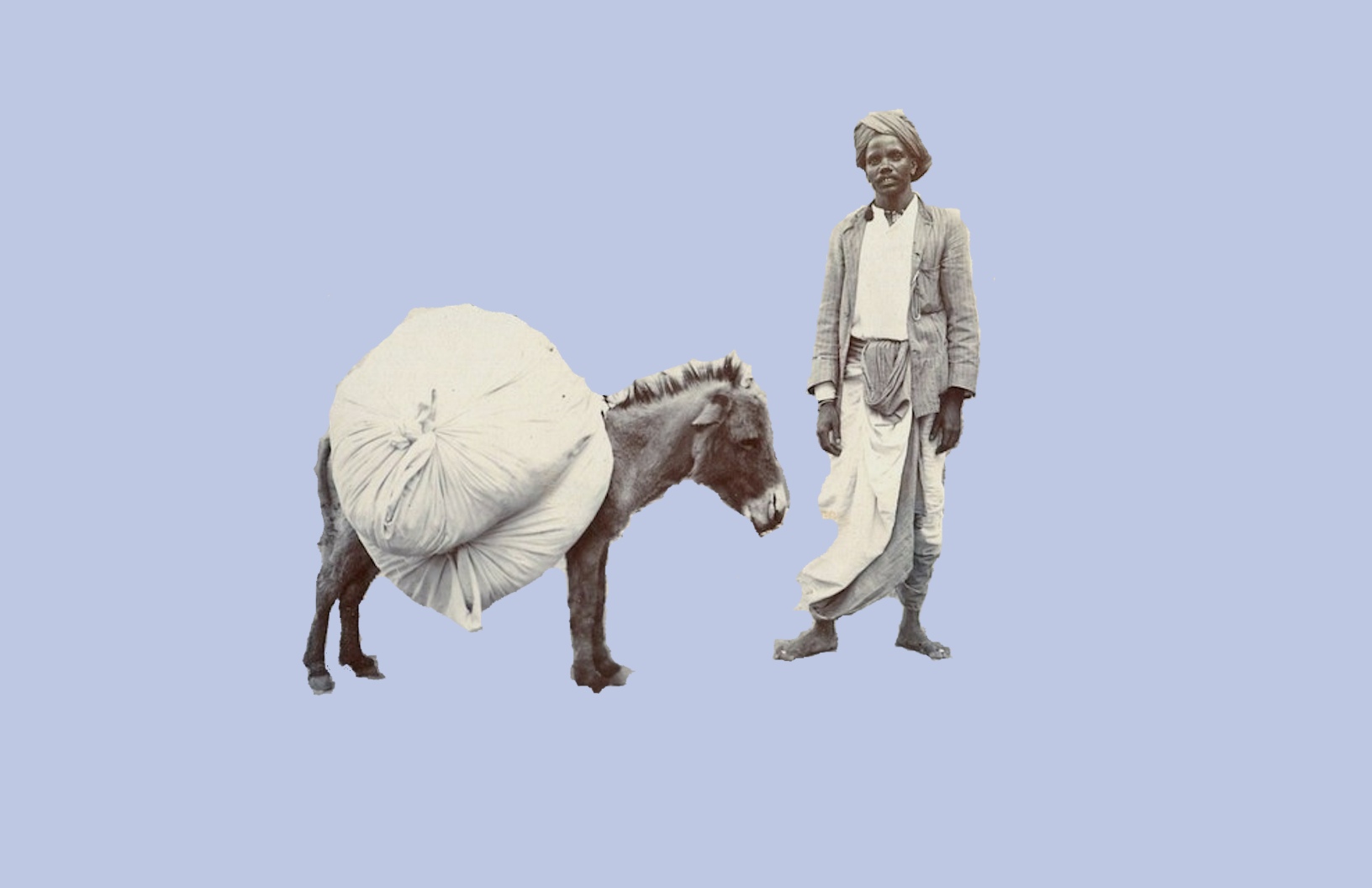
Yogi Damodaran lifts the Karma.
A pair of old people, husband, and wife, probably in their eighties were on their way at a snail's pace to see their son about two miles away from where they lived. They had a guard dog with them for protection and companionship. A feral cat made a living eating mouse in the neighborhood. It was the favorite of the townspeople, though no one invited the cat into their homes. The guard dog has been trained to move amicably with other people, cats, dogs... The cat knew the guard dog. It usually came near the dog, played with it for a few minutes, told the dog that the son of the old people was held hostage by a robber and went on its way. The Yogi overheard the news and alerted the neighbors about an intruder. They joined, went up the side of the house on to the roof and descended to the central open space in the house. They carried sticks with them. The yogi also joined them. They heard noise coming out of the bedroom in the house. The robber held the son, his wife and two children hostage. He bid them to open the safe and hand over the money and the jewels.
As they were about to open the safe, a stick came down heavily on the back of the robber. The blow disabled him completely. The rescuers caught him and handed him over to the police.
The Yogi was curious about the all-knowing cat. He went to the cat and asked it how it knew of the robbery in progress. The cat understood the yogi well and told him it was a yogi in its last birth. As yogi in the past life, he could not stop the cat burglar from entering a house, robbing and killing the newlyweds. That Karma was the reason he was born a cat in this birth.
The Yogi learning the harrowing story put his hand on the head of the cat. Lo and behold, the cat became the yogi it used to be in the past life. The feline yogi thanked profusely the other yogi for bringing back his old self.
